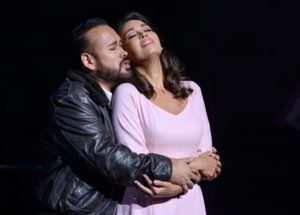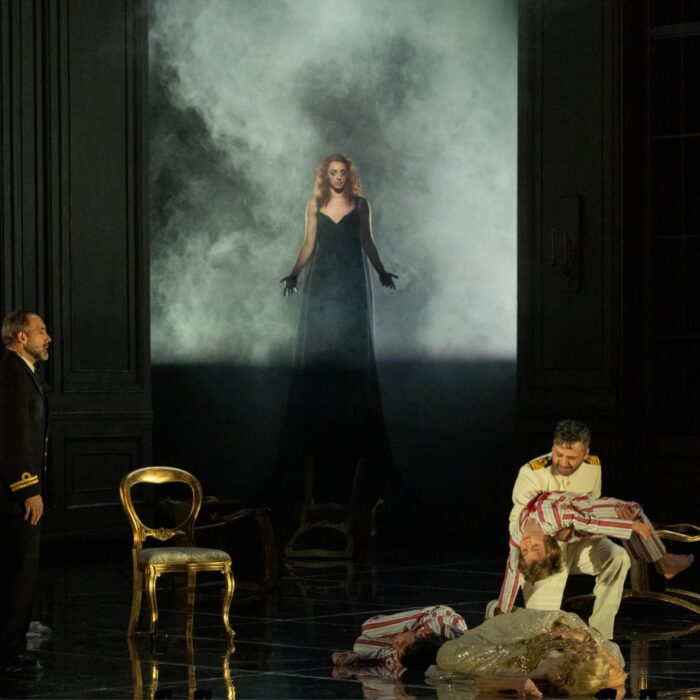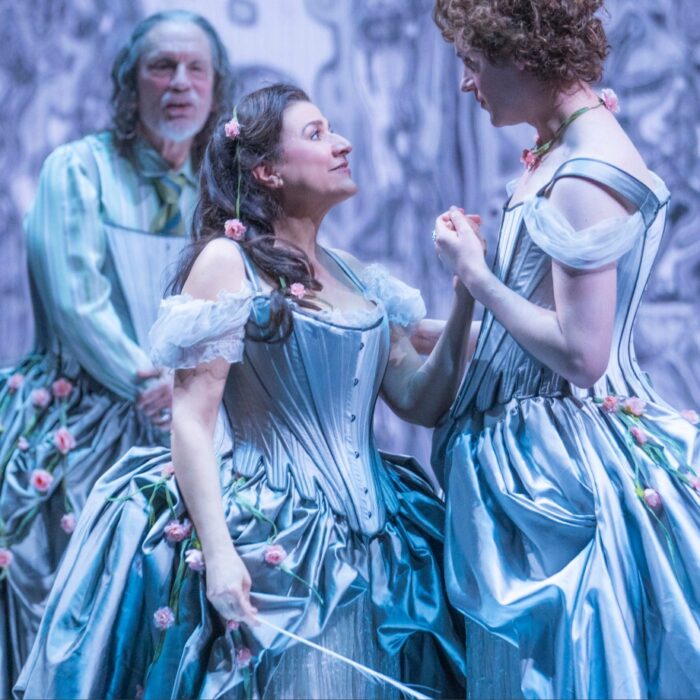
Gran Teatre del Liceu 2020-21 Review: Lucia di Lammermoor
Javier Camarena & Nadine Sierra Shine in a Mixed Production
By Mauricio VillaDonizetti’s “Lucia di Lammermoor” has been performed at the Gran Teatre del Liceu 302 times since its premiere in 1849. The work has remained a house favorite and was hugely anticipated since its last new production came in 2015. And for the closing production of the 2020-21 season, the Catalan Opera house lined up two of its famed interpreters, Nadine Sierra, making her house debut and audience favorite Javier Camarena. The result was spectacular with Sierra eclipsing the audience with her beautiful voice, impeccable technique, exquisite phrasing, sparkling high notes, and dramatic interpretation. She received such a tremendous ovation after the mad scene’s cadenza that conductor Giacomo Sagripanti was forced to break the never-ending applause to continue the opera.
A Dramatic Lucia
Sierra possesses a lirico-leggera instrument, with a sweet dark round timbre, a strong middle register, and pure coloratura with a bright secure top register. Her voice may not be large but she makes sure it is always present throughout every scene. On this evening Sierra sang the role with its traditional bravura and without cuts. The soprano’s voice enables her to accomplish the demands of the score all while interpolating high notes and coloratura roulades. She sang her entrance cavatina “Ancor non giunse…Regnava nel silenzio” with pathos and dramatism, coloring the phrases with a warm legato line. She was precise and cautious with the use of dynamics, filling the lines with crescendo/diminuendo without ever exaggerating the dramatic aspects of the aria. Instead, Sierra presented a young, naïve, and infatuated girl.
She revealed her sparkling high notes during the first aria when she sang a high B natural in “É conforto al mio penar” that was secure and round. During her cabaletta, “Quando, rapito in stasi” she brought vocal pyrotechnics singing the traditional variations during the repetition and showcased soaring pianissimi on her high B, C, and D. One of the great inclusions of the night was the usually cut coda where Sierra sang the coloratura line fluidly moving with ease from a low C to a high C.
Her seamless voice production was on display in her duet with Edgardo and she sang the line “Veranno a te sull’aure” in a single long fiato and Mezza Voce creating a soaring fluid legato phrase. She delivered the first sparkling high E flat of the evening on the line “Questo pegno” as the vocal lines were inverted (The high E flat belongs to the tenor line while the soprano only goes up to a high C).
During the Act two duets with Enrico and Raimondo, Sierra showcased the warm and dramatic qualities of her middle register. Here she did not use her chest voice but that increased the dramatic effect. She maintained her sound covered throughout the scenes. Sierra’s projection was especially noticeable in the famous sextet and final concertante at the end of the second act, where her voice was always present.
In the Act three Mad Scene, Sierra once again showed she was up to the test. Like the majority of the opera, the writing is very central, with the exception of an “oppure” B flat. However, there are high Bs and Cs that are interpolated by tradition. Sierra colored every line to create Lucia’s hallucinatory state showcasing the character’s sudden mood changes of sadness, joy, fear, and melancholy. She sang the traditional flute cadenza which displays staccato high notes, fast scales, and mezza voce. It also exposes the upper register and Sierra was up to the challenge culminating it with an E flat. She displayed vocal fireworks and her impeccable technique as well as her dramatic intentions which really made the entire scene meaningful and impactful. Her “Spargi d’amaro pianto” was sung the traditional variations on the repetition of the cabaletta and Sierra even added her own subtle variation in “al giunger tuo soltanto.” Like in the cadenza, she ended it with a clear and powerful E flat.
Her interpretation of the mad scene was hair raising, showcasing Lucia’s many mental states. There were so many extremes that made it a believable and moving interpretation from her hysteric laughter and desperate crying before the cabaletta to her hesitant movement and lost looks around the stage. It was one of the most dramatic mad scenes I have seen in many years and it was also very different from what one is accustomed to. In this production, Lucia is asked to sing the mad scene in a sparkling silver evening gown and perfect tight hair all while carrying a gun and singing to a microphone. In all, Sierra was the star of the evening, both vocally and dramatically, demonstrating complete control of the role and showcasing maturity and truth.
Superb Bel Canto Singing
The stylish Bel Canto tenor Javier Camarena portrayed Lucia’s lover Edgardo and brought impeccable singing to the evening. He sang with constant crescendos and diminuendos throughout his whole tessitura including a long mezza voce C sharp in his final scene “Tu che a Dio.” There were also long legato phrases during his duet with Sierra such as “Veranno a te sull’aure,” which he sang in one breath. Camarena also displayed bravura menacing moments and vibrant high notes.
There was a noticeable change in his voice as it has become darker and gained some consistency in the middle register that gives the voice more weight and dramatic color. His interpretation of the line, “Maledetto sia l’instante” was arduous and menacing and he even sang the frequently cut “Ah! ma di Dio la mano irata” before delivering a strong ringing B flat on “Vi disperda” with astounding strength and dramatism.
His vocal technique makes his singing effortless and one can admire the security and beauty of it. That was on full display in the final scene of the opera, which was the highlight of his performance. Camarena’s “Tombe degli avi mie and Tu che a Dio” was filled with perfect diction, impeccable phrasing, and outstanding use of dynamics. That made his interpretation of this climactic scene unique and unforgettable.
The Mexican baritone Alfredo Dara was making his role debut as Lucia’s brother Enrico. Dara has a strong metallic baritone voice and possesses a marked fair vibrato. His voice projects well and his timbre is even and balanced throughout his whole register. There is no apparent change in his timbre when he covers in the passagio so when he arrives at a high note, it seems like a natural extension of his voice. That was present in the traditional interpolated high G in his entrance aria, “Ah! Pria che d’amor si perfido.”
But what was most apparent of Dara’s performance was his interpretation of the character. His Enrico was angry and Dara showed that with the brave robust attack of his lines all while singing with a pure Bel Canto. He snags long legato lines and exquisite coloratura especially in his duets with Lucia in Act two and with Edgardo in Act three. His voice has body and volume, but there were times where it was hidden under the orchestra especially during his entrance cabaletta.
One interesting aspect of Enrico was that in the staging he was made to help Edgardo bandage his arm wound in the third act duet. However, this isolated sign of empathy with his enemy was awkward and unfulfilling. In all, Dara’s interpretation was strong, menacing, and authoritative.
The young Italian bass Mirco Palazzi sang the role of Raimondo with nobility. Palazzi is a Bel Canto specialist and he showed that with beautiful phrases and his use of dynamics. He was especially effective above the stave, an uncomfortable part of the basses range. The highlight of his performance was his second aria, ”Dalle stanze ove Lucia” which he sang with melancholic depth. He brought long floating lines and paid attention to all the dynamics in the score. However, both his low F and high F had no presence and the notes sounded distant and weak especially in the duet with Lucia in “Il pianto tuo saprá” and the low F in “la tremenda maestá.”
Tenor Emmanuel Faraldo was also noticeable as Arturo. His high lyric voice shined in the short passage, “Per poco fra le tenebre” and he sang effortlessly with clear diction and a gorgeous legato line.
An Original & Underwhelming Production
The production, directed by Barbara Wysocka, which originally opened at the Bayerische Staatsoper, did not convince the Liceu’s audience. The production does work on a theatrical level as the scenes have rhythm and constant action and the characters are clearly drawn. Wysocka succeeds in that she does not go against the music or the libretto and the actions are wisely placed and the staging makes the story clear.
However, the 50s American setting, which sees Lucia dress like Jackie Kennedy and Edgardo as a James Dean character, does not add any new meaning to the opera. It also might be confusing to see all the scenes happen in the same space, a big mansion hall that deteriorates throughout the opera. The characters interact between scenes making the action continuous and the significant leaps of time between scenes are lost. In the libretto months pass between Act one and two, yet, in this production, it seems to happen at the same time. Therefore, the time is a bit confusing, and it seems as if the story takes place in one day in the same place.
Setting the opera in the same location also does not help as it gives the impression that every scene takes place in a single environment and ultimately confuses the audience. There were also unnecessary props like a Cadillac which caused laughter when Edgardo entered the stage for the first time in reverse. The car becomes essential in this production, as it appears at the beginning of Act three and stays until the end of the opera. However, it does not bring further meaning to the action and therefore feels useless. The one positive aspect of the single hall set was that it was a closed box that had a good acoustic and allowed the singers to project within the facility.
Italian conductor Giacomo Sagripanti was in charge of the Orquesta Sinfónica del Gran Teatre del Liceu and filled the music with enthusiasm and energy. He made Donizetti’s sparse orchestration into strong atmospheric music. There were big contrasts between the slow tempi, particularly in the prelude and the mad scene, and the fast tempi. Enrico’s cabaletta and the second act concertante were especially driven by a fast tempo. It is worth mentioning that harp soloist Tiziana Tagliani played an extended introduction to Lucia’s cavatina and showed her virtuoso technique with multiple fast scales and a dramatic and atmospheric musical approach.
However, there were two moments, “Per te d’immenso giubilo” and Edgardo’s “Ah! Maledetto sia l’instante,” where the ensemble became unbalanced and the chorus and Camarena went ahead of the music. But Sagripanti managed to adjust the tempi quickly and made the chorus and the tenor come together.
Ultimately, Camarena and Sierra succeeded in this production that added nothing new to a beloved work.


